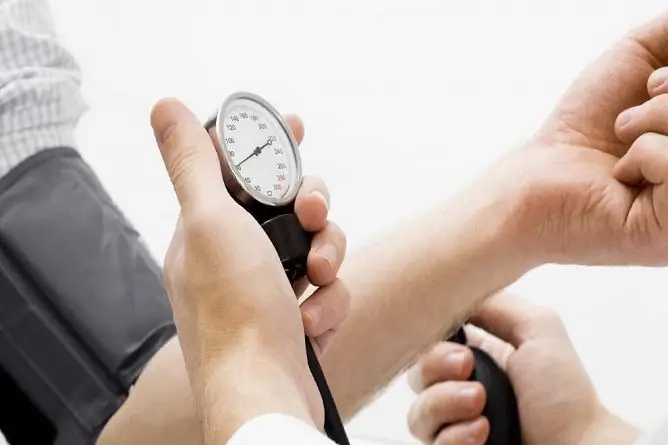- Author Rachel Wainwright [email protected].
- Public 2023-12-15 07:39.
- Last modified 2025-11-02 20:14.
Blood pressure and cervical osteochondrosis
The content of the article:
- Why, against the background of cervical osteochondrosis, pressure can increase
- Symptoms of cervical osteochondrosis accompanied by hypertension
- How to treat a combination of high blood pressure and cervical osteochondrosis
- Preventive measures
- Video
Cervical osteochondrosis and pressure exceeding the norm - what do these pathologies have in common? What is the relationship between them? Low or high pressure is noted against the background of a lesion of the spine, and what to do in case of increased pressure in osteochondrosis of the cervical spine? These questions concern many patients.
According to the World Health Organization (WHO), degenerative diseases of the spine are recorded in 70-90% of people in the age group over 50, and back pain is in second place (after acute respiratory diseases) among all reasons for seeking medical help. Cervical osteochondrosis relatively often develops in patients aged 20-40 years. Vertebral pain syndrome caused by degenerative-dystrophic changes in osteochondrosis is diagnosed in about 50% of adults. Osteochondrosis of the cervical spine often leads to an increase in blood pressure (BP).

Cervical osteochondrosis complicates the course of hypertension, and also complicates its treatment
High blood pressure occurs in patients of all ages, but is more common in people over 40. The combination of cervical osteochondrosis and hypertension can cause serious complications, which often leads to disability.
To diagnose osteochondrosis of the cervical spine, against the background of which arterial hypertension has developed, collect complaints and anamnesis, computer and / or magnetic resonance imaging, X-ray examination of the cervical spine, ultrasound examination of the blood vessels of the brain and neck, etc.
Why, against the background of cervical osteochondrosis, pressure can increase
The main causes of arterial hypertension include a genetic predisposition, overweight, excessive mental stress, the presence of bad habits, a passive lifestyle, atherosclerotic vascular disease, diseases of the cardiovascular, urinary system, etc. The intake of natural stimulants and certain medications affects the level of blood pressure, time of day, pressure can also rise in women during pregnancy.
Osteochondrosis can occur due to congenital anomalies of the spine, injuries, metabolic disorders, changes in hormonal levels, excessive physical exertion. In addition, there is a relationship between the incidence of pathology and age (osteochondrosis often occurs against the background of age-related changes in the human body).
Can the pressure increase with cervical osteochondrosis in a patient? High blood pressure is observed in about 40% of patients with cervical osteochondrosis. The cervical vertebrae are more mobile than the vertebrae of the thoracic and other parts of the spine, which is caused by the need to perform neck turns. This mobility makes this department more vulnerable. In addition, this is facilitated by the weakness of the neck muscles and the proximity of the vertebrae to each other. Because of this, even a slight displacement of the cervical vertebrae leads to compression of blood vessels and nerves.
Large-caliber blood vessels pass through the cervical region, which include the vertebral arteries that supply blood to the brain. For this reason, when such vessels are pinched, the blood supply to the brain tissues is disturbed, including the departments that are responsible for regulating the work of the cardiovascular system and the level of blood pressure. The reduced oxygen content in the tissues, which is observed against the background of circulatory disorders, causes an increase in blood pressure.
Cervical osteochondrosis is not always the cause (or the only reason) for the development of arterial hypertension, however, against its background, the symptoms of pathology become more pronounced. In the presence of osteochondrosis of the cervical spine, conventional methods of treating hypertension may be ineffective.
Symptoms of cervical osteochondrosis accompanied by hypertension
In favor of the presence of osteochondrosis of the cervical spine may be evidenced by a crunch when turning the head, weakness, drowsiness, and fatigue. At the initial stage of arterial hypertension with cervical osteochondrosis, sudden attacks of dizziness, nausea, ringing in the ears, pain in the shoulders, darkening in the eyes (especially when the patient changes the position of the body), shortness of breath, paroxysmal pressing pain behind the breastbone are usually observed. Systolic (upper) pressure rises more often. In the case of high blood pressure in osteochondrosis, the patient has neck pain, pressure surges (especially with protrusions, hernia in the cervical spine), pain in the shoulder girdle and upper limbs, pain in the heart, heart rhythm disturbances, numbness and / or sensation tingling in the fingers, numbness of the tongue.
Headache in case of increased blood pressure in cervical osteochondrosis occurs in the cervico-occipital region, spreads to the forehead, temples, and the periocular region. The pain can be localized only on one side of the head, usually develops after a long stay in a stationary state, increases with bending, head movements. Vestibular disorders, hearing and vision impairment are possible.
Against the background of cervical osteochondrosis, the patient has an increase in blood viscosity, a violation of its microcirculation, a deterioration in blood flow in the main blood vessels. In this case, patients may experience circulatory failure in the vertebrobasilar system and hypertensive encephalopathy. With high blood pressure and cervical osteochondrosis, the risk (up to 40%) of the development of ischemic stroke in a patient increases.
How to treat a combination of high blood pressure and cervical osteochondrosis
The presence of a spinal lesion can lead to ineffectiveness of the therapy for arterial hypertension, more frequent occurrence of hypertensive crises. Massage and physiotherapy procedures, which can be prescribed to a patient with cervical osteochondrosis, in some cases can lead to an even greater increase in blood pressure. Treatment of cervical osteochondrosis with increased pressure can be complicated by the fact that non-steroidal anti-inflammatory drugs, which are often used to eliminate inflammation and pain, in such patients can cause complications, as they promote fluid retention and reduce the effectiveness of antihypertensive drugs used due to their effect on prostaglandins …
The main areas of treatment are usually:
- elimination of angiodystonic syndromes and neuromuscular disorders;
- normalization of blood viscosity;
- restoration of energy exchange in brain cells, improvement of blood supply to the brain and sympathetic regulation.
Drug therapy for cervical osteochondrosis with high blood pressure includes taking muscle relaxants, antihypertensive, nootropic drugs, etc. To eliminate pain in the cervical spine, analgesics are prescribed in a short course.

With increased blood pressure, patients with osteochondrosis can be helped by therapeutic exercises
Some patients are shown wearing an orthopedic collar (Shants collar) in order to compensate for the load on the cervical spine, as well as manual therapy.
According to patients' reviews, from folk remedies, rubbing the neck area with a mixture of iodine (10 ml), ethyl alcohol (300 ml), camphor oil (10 ml), analgin (10 crushed tablets) has proven itself well. The tool is insisted for 20 days in a dark place. You can also rub St. John's wort oil into your neck, which is also used for compresses and added to the bath water.
Physical therapy is shown. For the correct performance of the exercises, it is recommended to conduct classes in the presence of an exercise therapy trainer. Simple neck gymnastics will prevent hypertension and may help fight osteochondrosis.
Preventive measures
The same methods are used to prevent cervical osteochondrosis and arterial hypertension. It is recommended to correct the daily regimen, establish a night's sleep, observe an adequate mode of work and rest, and avoid stressful situations. You should give up bad habits, you need to include vegetables, fruits, dairy products in the diet, excluding or limiting the use of table salt, fatty and fried foods. Regular walks in the fresh air are recommended.
Video
We offer for viewing a video on the topic of the article.

Anna Aksenova Medical journalist About the author
Education: 2004-2007 "First Kiev Medical College" specialty "Laboratory Diagnostics".
Found a mistake in the text? Select it and press Ctrl + Enter.






